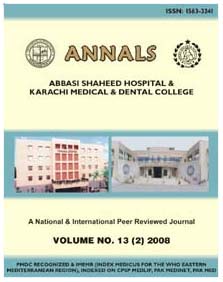
| |
| Home |
| Editorial Staff |
| Instruction to Authors |
| Journal-Issues |
| Policy |
| Copyright |
| CHILDHOOD PNEUMONIA-ORGANISMS AND THEIR PATTERN OF SENSITIVITY
1SULTAN MUSTAFA, 2SADIQ MIRZA, 3SUMBAL WAHEED, 4IBRAHIM SHAKOOR ABSTRACT Objective: To isolate causative organisms of pneumonia in children between 2 months to 5 years and to determine the sensitivity pattern of these organisms. Material & Methods: It was an observational study in children presented with fever,cough or difficulty in breathing in outpatient department or emergency room of pediatrics department of Abbasi Shaheed Hospital, Karachi. The study was carried out in the department of Paediatric, Karachi Medical & Dental College and Abbasi Shaheed Hospital over a period of ten months (17 -01-08 to 15-11- 08). Children between 2 months to 5 years, who present at outpatients department or in emergency room with complaint of fever,cough or/and difficulty in breathing were included in study. 100 cases of pneumonia fulfill WHO criteria who visited out patients and in emergency room during this period were enrolled in the study. The diagnosis is made by observing respiratory rate more than 50 per minute if the child was 2 months to 12 months and 40 per minute or more if the child was 12 months to 5 years of age. A nasopharyngeal swab was taken from each child for culture and sensitivity pattern. The idea behind choosing this site is that, obtaining nasopharyngeal swab is very simple, safe and without the risk of any serious complications. Result: Majority of pneumonia cases are occurring under two years of age (85%) and maximum number of pneumonia cases are occurring under 1 year (54%). Sex distribution of pneumonia cases of the study showing that out of 100 cases of pneumonia 60 were males and 40 were females. A male to female ratio of 3:2.Two most common pathogens i.e. S.pneumoniae (60%) and H.influenzae(25%) are mainly responsible for childhood pneumonia and these organisms are well covered with the first line antibiotics recommended by WHO ARI programme for out patient treatment of pneumonia i.e. co-trimoxazole, amoxycillin and ampicillin Streptoccocus pneumonia is sensitive to amoxicillin 98%,co-trimoxazole 80% and ampicilln 98% while sensitivity of H. influenza with amoxicillin, .co-trimoxazole and ampicilin is 91%,91% and 100% respectively. Conclusion: The organisms isolated in this study and their sensitivity pattern shows that two most common pathogens of pneumonia are S.pneumoniae and H.influenzae and these organisms are well covered with the first line antibiotics recommended by WHO ARI programme for out patient treatment of pneumonia i.e. co-trimoxazole, amoxicillin and ampicillin. Key words: Pneumonia,Cough,Co-trimoxazole .
|
For Full text contact to:
|
|
*.
|

Copyright © 2009 Abbbas Shaheed Hospital and Karachi Medical & Dental College.
All rights reserved.
Designed & Developed by: Creative Designers